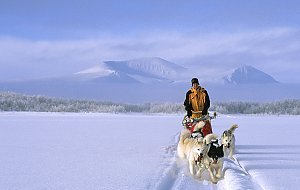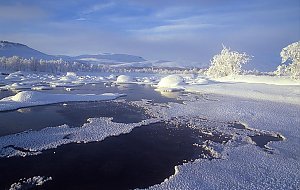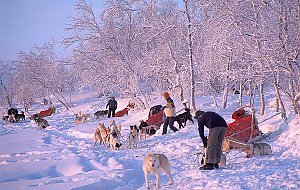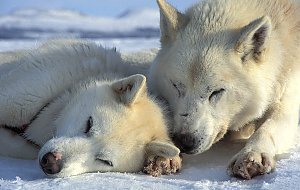
A perfect first time tour
A base camp along the 50 kilometre long Altevatn is central in this tour. It will be the starting point for trips lasting one or more days, to the southern parts of Dividalen National Park and to the Norwegian-Swedish border area.
This base camp, is a modest cabin, that can be reached within one or two days dog sledding across Lake Altevatn – depending on the snow conditions. From here a number of more challenging tours can be arranged.
Other cabins can also be visited from here. The majestic mountains and the lower forests offer numerous possibilities. In addition, the lakes are great for ice fishing.
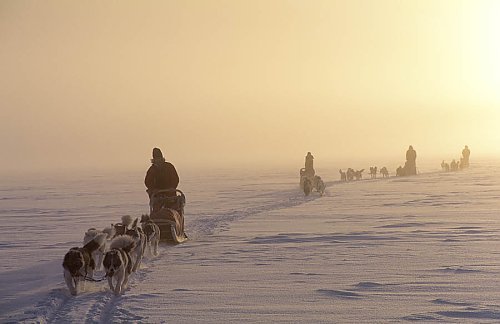
Participants may handle their own sled and dog team. That way, everyone has the responsibility to harness the dogs, feed them etc.
Before the tour starts, we give an extensive introduction to dog sledding. Soon the most important lessons are learned, and your skill will improve steadily during the tour.
To handle the dogs and the sledge is a main issue on each tour. The tour guide will lead the first team, and will be available to assist you whenever necessary.
For this tour there are no specific requirements for the participants.
This tour is designed as a pure beginners’ tour. Suitable for those who have little or no “outdoor experience” and do not have much athletic ability. Nevertheless, you need to be in good shape. It also makes this tour more enjoyable.
We pick you up at your arrival point mehr ...
Arrival at Bardufoss airport or Setermoen bus station. Here you will be picked up by your musher and taken either to Björn and Regina’s husky farm Innset or to Jan and Ane’s husky farm – depending on who your guide is. At the respective husky farm you will be greeted by the four-legged participants of the tour and a cabin/guest house with all comforts such as shower, kitchen, etc. The first details of the tour are discussed over dinner.
(Of course, you can also arrive a few days earlier. This gives more time for fun in the snow: meeting huskies, snowshoeing or skiing on your own, trying out “Snørrekjøring”, relaxing in the sauna, acclimatising.)
This day is used completely for the preparations of the expedition mehr ...
First, everyone is assigned their team so that dog and human can get to know each other.
Then it’s time for instruction in the art of dog sledding. The aim is to enable each participant to handle the dogs and the sledge as independently as possible. All questions will be dealt with: Which dog goes where? What are all the leashes for? What do I do if I fall over? The harnessing and leashing of the dogs is practised and a small yard round with a complete team gives first impressions of the fun to be expected.
Another important point is the equipment. Here, the participants’ equipment is thoroughly checked for suitability and missing items are added. The participants’ equipment should be able to cope with all conditions. In order to guarantee this, we can also fall back on our extensive equipment warehouse.
A look at the map will give you an approximate idea of how the tour will proceed.

Then the sledges are packed, the dogs harnessed and the starting lines loosened mehr ...
Now, at last, the adventure begins, which at first consists only of white landscape flying by and a pack of extremely eager dogs. However, the four-legged friends quickly come to a calmer wolf trot – the holiday can begin.
In order not to make the beginning too difficult, the stage runs on the ice of Lake Altevatn. No great driving or steering skills are needed here.
Depending on the snow conditions and the mood of the participants, either a hut or a lavvo can be approached. The lavvu is the traditional tent of the Sami people. A stove in the middle and reindeer skins on the floor make for a traditional and cosy end to the day.
For these days there are many possibilities to be out with the dogs mehr ...
On these days, you can either aim for new huts about 20 kilometres away or go on day trips. The landscape offers all possibilities: From high mountains to wooded valleys to the ice of large and small lakes.
In the mountains, the interaction between man and dog is very intense. The dogs need to be helped, because they want to be encouraged and motivated to climb the mountain ranges. As a highlight, the heights offer good views of the surrounding landscape. To the west, south and north, the mountain ranges of the Norwegian mountains rise into the sky, while the flatter tundra and taiga towards the east is already on Swedish territory.
The valleys are forested with birch trees. Here you have to steer a little to avoid the trees. You can often see the tracks of various animals. The fox and the snow hare dominate. But the tracks of the lynx and wolverine also cross the valleys. The cackling of the ptarmigan can often be heard. They live in large groups and feed on the buds of the birch and willow bushes in the shelter of the mountain cuts. Now and then they fly up in front of the approaching sledges to settle down again not far away.
The lakes are covered with a metre-thick layer of ice. They are not very demanding from a technical point of view. The quiet progress on them allows you to enjoy the landscape and the husky team to the fullest.
Challenges abound and can be adapted to the needs of the group.
Snowshoe excursions or fishing luck can also be tried out.
The sledges are now free of provisions and run much easier mehr ...
The dogs quickly realise that it’s time to go home and put on their harnesses once more. After a few hours we reach the small settlement of Innset and the warm shower. But before that, the dogs have to be unharnessed and the sledges unloaded.
The day ends with a warm dinner. Here, Norwegian cuisine will prove that it has something else to offer than “Smørebrød”.
After breakfast we say goodbye to the dogs mehr ...
Breakfast, farewell to the dogs and transfer to the departure points.
PS: Due to bad weather conditions, significant snowfall or avalanche danger, the route may change. However, we have several alternative routes to choose from.
| Time | Length | Operator | Available places | |
|---|---|---|---|---|
| Saison 2025/2026 | ||||
| 2026/01/16 - 2026/01/23 | 5+3 days | Morten Klauer | 0 | Fully booked |








